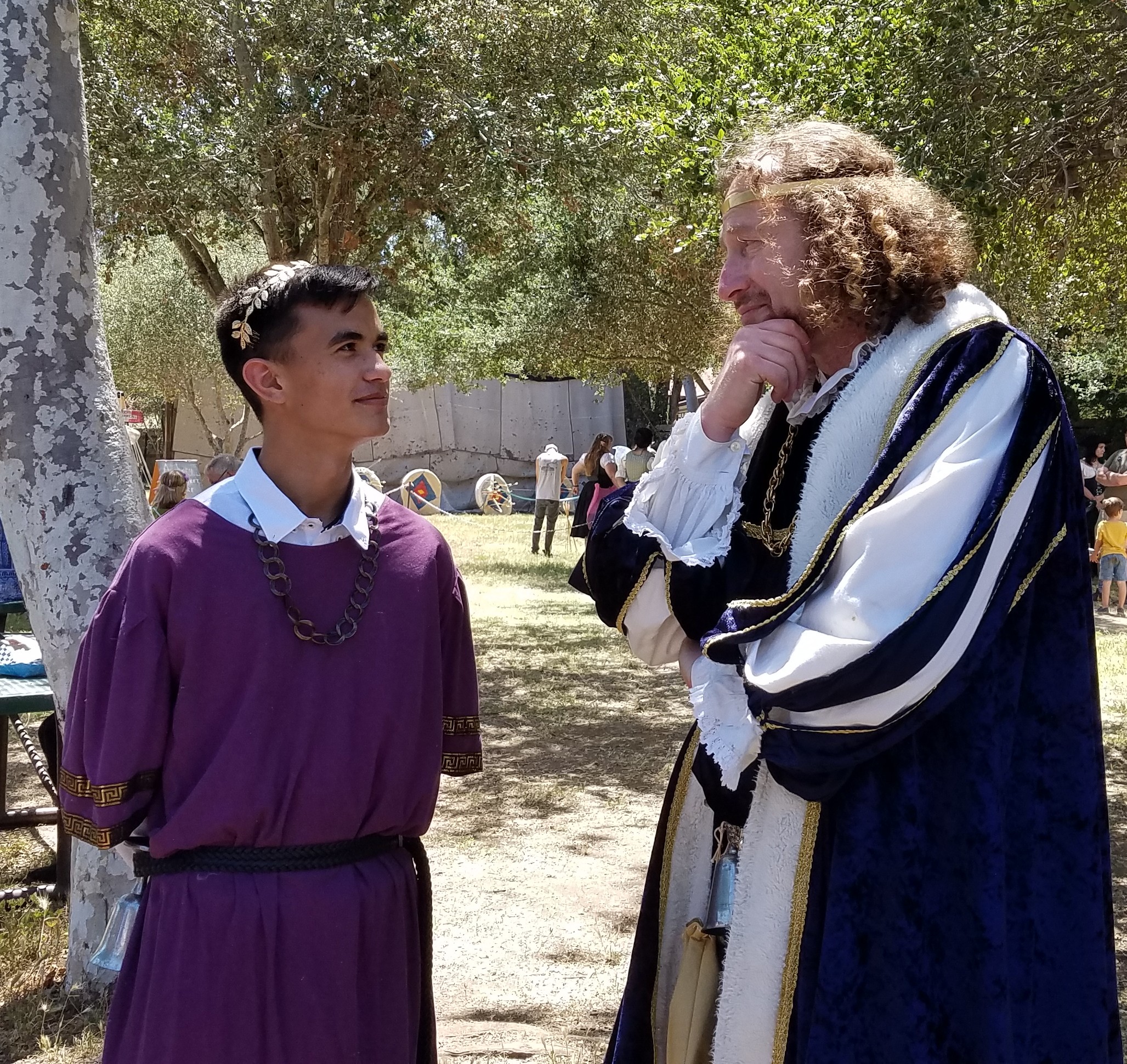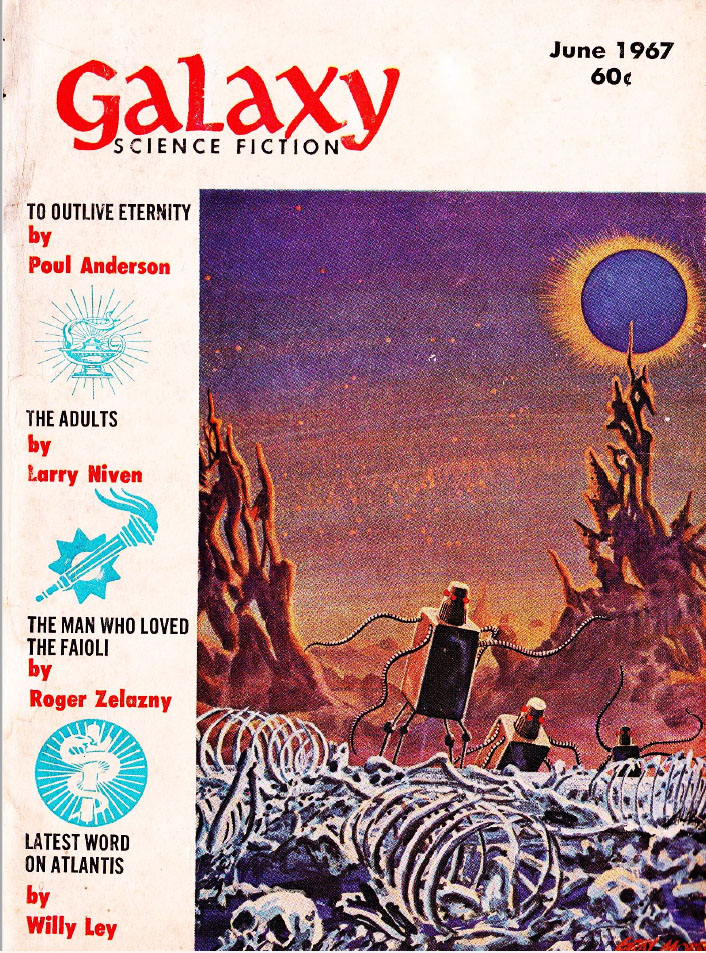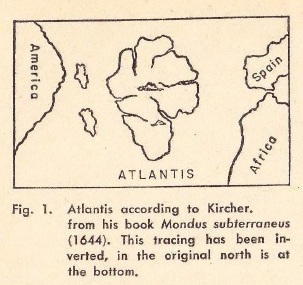
by Gideon Marcus
Living in the Past

Dancing on the main stage
The Renaissance Pleasure Faire has really taken off since it first opened in 1963. Sort of a reaction to modern society, it is several acres of the 16th Century surrounded by semi-arid modern Southern California. And as a refuge from the horrors of today (and sanitized to be free of the horrors of yesterday), it has become a prime sanctuary for hippies and other counter-culture freaks to enjoy some solace.

A typical scene–we pretend the "mundanes" aren't there…
And the Journey is no exception!

Iacobus of Constantinople (left) confers with Lord Sir Basil, Count of Argent (me!)

Lorelei has found her chosen weapon.

Captain Clara Hawkins (time traveling from the 17th Century) and Lorelei ride unicorns.

Good writers don't grow on trees, but some, like Elijah, play in them.

The whole gang. Note associates Elijah (purple, third from left), Joe (center, back), Abby (gold, center front), Lorelei (to her right), and Tam (second from right).
Living in the Future
The pages of this month's Galaxy also offer an escape, and for the most part, a pleasant one!

by Gray Morrow
To Outlive Eternity (pt 1 of 2), by Poul Anderson
Things open with a literal bang. The Leonora Christine, zooming through space at relativistic velocities on a mission of colonization, rams into a small nebula at near light speed. Though the 50 or so crew and scientists are unhurt, the ship has lost its ability to decelerate. It is now doomed to travel through the galaxy and beyond, its tau (or time) compression factor ever increasing, such that the entire life of the universe might pass in a lifetime.
Earth is now long in the past; can the Leonora Christine's complement effect repairs such that they can at least someday cease being a cosmic Flying Dutchman?

by Jack Gaughan
Poul Anderson, when he's got his blood high, fuses science and character better than most (when he's in it for the paycheck, he gets the science right, but the rest is dull as dishwater). The near-light Bussard ramjet concept was explored recently in Niven's The Ethics of Madness, but this gripping tale promises to reward the reader more fully.
Four stars.
Mirror of Ice, by Gary Wright
Gary must have recently watched Grand Prix, for his tale of high-speed bobsledding of the future, with its 10% fatality rate per race, strongly evokes that vivid movie. Or the author is just a big racing fanatic. After all, such was the topic of his last story.
Anyway, perfectly acceptable, if not too memorable; I wonder if he'd originally intended this for Playboy…or Sports Illustrated!
Three stars.
Polity and Custom of the Camiroi, by R. A. Lafferty
A three-person anthropological team investigates the highly libertarian planet of Camiroi. Society there is highly advanced, seemingly utopian, and utterly decentralized. Sounds like a Heinleinesque paradise. However, there are indications that the Terrans are being put on, mostly in an attempt to just get them to leave.
The result is something like what might have happened if Cordwainer Smith and Robert Sheckley had a baby. That'd be one weird tot…but an interesting one.
Four stars.
The Man Who Loved the Faioli, by Roger Zelazny
The Faioli are ethereal beauties who appear in a man's (or a woman's?) last month of life. Or perhaps they are the cause of impending demise. In any event, they pay for the quick mortality with the most pleasant company imaginable, perhaps feeding on the emotional feedback.
Here is the tale of a man living-in-death (or dead in living?) who romances a Faioli and remains to tell about it.
Zelazny is capable of beautiful, effective prose, but sometimes, it seems he just waxes purple and hopes his readers can't tell the difference. This one feels like the latter.
Three stars.
For Your Information: Another Look at Atlantis, by Willy Ley

Mr. Ley, Galaxy's science columnist, is back to form with this quite interesting article on all we know for certain (and it's not much!) about the mythical continent of Atlantis. Worth a read.
Four stars.
Spare That Tree, by C. C. MacApp

by Dennis M. Smith
Inspector Kruger of the Interstellar Division is back (we first saw him in the January issue of IF). This time, he's on the trail of a kidnapped tree, prized possession of an Emperor whom the galactic federation wishes to keep on the good side.
David observed that Laumer or Goulart could do a better job with these tales, and they are, indeed, the authors I was reminded of while reading this piece. It starts out genuinely interesting and funny, but the last half meanders into a whimper.
A high two (or a low three, depending on your mood).
Howling Day, by Jim Harmon
In this epistolary, an agent keeps sending a spec script to the wrong kinds of publishing houses. They all appreciate the quality of the work, but it's not quite right for what they put out. Which makes sense–turns out it's not a spec script at all…
I found this one a bit tedious and old-fashioned. Two stars.
The Adults, by Larry Niven

by Virgil Finlay
From the center of the galaxy comes Phthsspok, a super-intelligent, highly determined alien looking for a long lost colony. He has reason to believe it is Earth…or was, hundreds of thousands of years ago. Phthsspok is a Protector, with armored hide and hyper-reflexes. Utterly beyond human capabilities.
Except, when Phthsspok runs across and kidnaps Jack Brennan, a Belter in his middle-40s, the connection between Protectors and humanity turns out to be closer than anyone expected.
Set in the same time and setting as World of Ptavvs, and featuring Lucas Garner and Lit Schaeffer from that book, The Adults is a fascinating read. And it offers the compelling question: would you trade your sex and your outward humanity at age 45 for the privilege of immortality and extreme intellect?
Forty-four year olds in the audience, are you reading?
Four stars.
Alien's Bequest, by Charles V. De Vet
Wrapping things up, we have a new twist on The Puppet Masters. It's mildly intriguing, and I am always happy to see De Vet's name, but ultimately, the story doesn't quite go anywhere.
Three stars.
Return to Reality
What a nice weekend that was! First centuries past, then centuries to come. I'm not sure I'm ready to face Vietnam, another summer of protests, or a second season of The Invaders.
Oh look! The June issuse of Fantasy and Science Fiction has arrived. Just in time…


 The Baltimore Nine shortly after their arrest. Fr. Philip Berrigan is 2nd from the left in the back row.
The Baltimore Nine shortly after their arrest. Fr. Philip Berrigan is 2nd from the left in the back row.
 Abbott and his men are the first to reach the Sleeper’s chamber. Art by Gray Morrow
Abbott and his men are the first to reach the Sleeper’s chamber. Art by Gray Morrow
![[June 2, 1968] Necessary Evils (July 1968 <i>IF</i>)](https://galacticjourney.org/wp-content/uploads/2023/05/IF-1968-07-Cover-543x372.jpg)
![[May 12, 1967] There and Back Again (June 1967 <i>Galaxy</i>)](https://galacticjourney.org/wp-content/uploads/2022/05/670512cover-672x372.jpg)














![[December 2, 1966] Mixed Bags (January 1967 <i>IF</i>)](https://galacticjourney.org/wp-content/uploads/2021/11/IF-1966-12-Cover-665x372.jpg)
